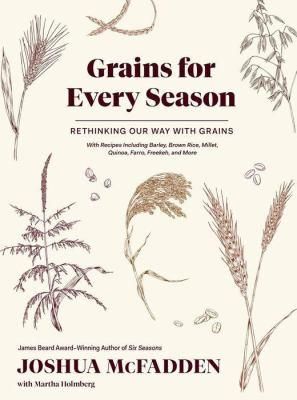Bibliobites in January: Going with the Grain
February 15, 2023 Book Groups Library Staff
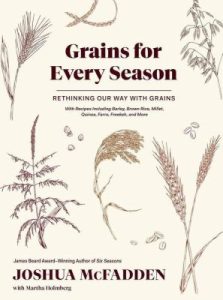 This January was a grainy month. To start with, the weather was unusually, depressingly, gray and rainy; and with a little funky math, gray + rainy = grainy! More to the point, our Bibliobites group tackled Grains For Every Season by author and restauranteur Joshua McFadden. The author's first book, Six Seasons: A New Way with Vegetables, is an award-winning tome showcasing fresh, seasonal vegetables in simple, innovative ways. Did this sophomore effort live up to the first? And perhaps more importantly, did we find new ways with familiar grains, and/or new grains to love?
Eating whole grains isn't a remotely recent idea; as the author points out, grains have sustained humanity for untold centuries. Though some grains may not yet be familiar to Americans, new awareness of grains' healthfulness, versatility, and satisfying flavors has led to greater availability, and therefore more widespread use. McFadden aims to keep us moving in that inclusive direction, using familiar grains and flours in new ways, and using less-common grains in traditional dishes (for example, using farro to make "risotto"). In addition to recipes, this title is a treatise of sorts on the botany of grains, how they're grown and processed, and how best to cook and store them. This information was overkill for some, but others enjoyed the in-depth background. Trying out those new grains sometimes required a bit of shopping around, either to a natural foods store or online. However, a surprising number were available at local supermarkets. Each chapter of the book highlights a particular grain, and includes a mixed bag of recipes, from appetizers to desserts.
This January was a grainy month. To start with, the weather was unusually, depressingly, gray and rainy; and with a little funky math, gray + rainy = grainy! More to the point, our Bibliobites group tackled Grains For Every Season by author and restauranteur Joshua McFadden. The author's first book, Six Seasons: A New Way with Vegetables, is an award-winning tome showcasing fresh, seasonal vegetables in simple, innovative ways. Did this sophomore effort live up to the first? And perhaps more importantly, did we find new ways with familiar grains, and/or new grains to love?
Eating whole grains isn't a remotely recent idea; as the author points out, grains have sustained humanity for untold centuries. Though some grains may not yet be familiar to Americans, new awareness of grains' healthfulness, versatility, and satisfying flavors has led to greater availability, and therefore more widespread use. McFadden aims to keep us moving in that inclusive direction, using familiar grains and flours in new ways, and using less-common grains in traditional dishes (for example, using farro to make "risotto"). In addition to recipes, this title is a treatise of sorts on the botany of grains, how they're grown and processed, and how best to cook and store them. This information was overkill for some, but others enjoyed the in-depth background. Trying out those new grains sometimes required a bit of shopping around, either to a natural foods store or online. However, a surprising number were available at local supermarkets. Each chapter of the book highlights a particular grain, and includes a mixed bag of recipes, from appetizers to desserts.
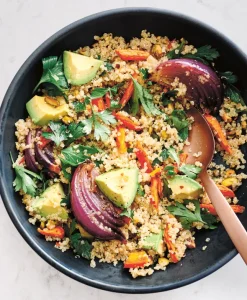 New-age darling quinoa was featured in roasted carrot, avocado, pistachio, and quinoa salad. This was a hit for both people who tried it; it was a harmonious combination of "ingredients that I love." And the pistachios added welcome crunch. Quinoa also appeared in super grain and veggie burgers, along with rolled oats, barley, chickpeas, and more. As the author notes, with all those ingredients the burgers are a bit of a project; but the recipe makes 12 and they freeze well. Mushrooms and garlic added plenty of savory depth; carrots provided a bit of sweetness. By happenstance or design, the burgers are vegan, which meant eggs weren't used as a binder; and this was problematic. Even though they tended to fall apart, they were "a really good veggie burger....I would make again."
Freekeh, a form of wheat that's harvested while still green, was one of the grains that was less available locally (Whole Foods carries it). Our cook used it in freekeh falafel, where unfortunately, "the freekeh didn't blend in as well [as I would have liked]." The accompanying spicy creamy green sauce was a hit, though. But, "I still like the traditional style better." A form of wheat with which we're all very familiar, whole wheat flour, was baked into whole wheat pitas. These were easy to make and went well with the aforementioned falafel, though they were a bit too salty. Whole wheat foccaccia was something of a project, requiring two overnight risings, but it was worth the effort, "really tasty...the [1/4 cup] rye flour added a certain je ne sais quoi." Note to purists: this recipe is more than half white flour, though the author encourages you to play with the proportions.
New-age darling quinoa was featured in roasted carrot, avocado, pistachio, and quinoa salad. This was a hit for both people who tried it; it was a harmonious combination of "ingredients that I love." And the pistachios added welcome crunch. Quinoa also appeared in super grain and veggie burgers, along with rolled oats, barley, chickpeas, and more. As the author notes, with all those ingredients the burgers are a bit of a project; but the recipe makes 12 and they freeze well. Mushrooms and garlic added plenty of savory depth; carrots provided a bit of sweetness. By happenstance or design, the burgers are vegan, which meant eggs weren't used as a binder; and this was problematic. Even though they tended to fall apart, they were "a really good veggie burger....I would make again."
Freekeh, a form of wheat that's harvested while still green, was one of the grains that was less available locally (Whole Foods carries it). Our cook used it in freekeh falafel, where unfortunately, "the freekeh didn't blend in as well [as I would have liked]." The accompanying spicy creamy green sauce was a hit, though. But, "I still like the traditional style better." A form of wheat with which we're all very familiar, whole wheat flour, was baked into whole wheat pitas. These were easy to make and went well with the aforementioned falafel, though they were a bit too salty. Whole wheat foccaccia was something of a project, requiring two overnight risings, but it was worth the effort, "really tasty...the [1/4 cup] rye flour added a certain je ne sais quoi." Note to purists: this recipe is more than half white flour, though the author encourages you to play with the proportions. 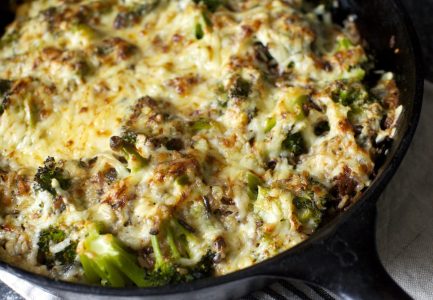 Broccoli, tuna, and wheat berry gratin used wheat in its least-processed form, wheat berries. This riff on '50s tuna noodle casserole was a huge hit, just "really good!" There were a couple of minor issues: the wheat berries needed to cook longer than the recipe indicated, and the broccoli needed to be cooked a bit less!
Winter fave barley had its moment, appearing in the veggie burgers above, and in lightly curried lamb, cabbage, and barley soup. This soup had a "beautiful" broth, and the combination of lamb and cabbage was "so good!" The barley added nice heft, always welcome on a cold day. One caveat: lamb shanks are no longer an inexpensive choice! Farro, another form of wheat that has a similar flavor and texture as barley, made for a wonderful farrotto in the style of cacio e pepe. This risotto clone was peppery and cheesy in the best possible way, a bowl of nourishing comfort food for a chilly winter night. Like risotto, there was a fair amount of stirring involved, but on the whole it was simple to make.
That '70s favorite, brown rice, is still popular today, and for good reason. It's tasty, inexpensive, and available everywhere. Semi-traditional
Broccoli, tuna, and wheat berry gratin used wheat in its least-processed form, wheat berries. This riff on '50s tuna noodle casserole was a huge hit, just "really good!" There were a couple of minor issues: the wheat berries needed to cook longer than the recipe indicated, and the broccoli needed to be cooked a bit less!
Winter fave barley had its moment, appearing in the veggie burgers above, and in lightly curried lamb, cabbage, and barley soup. This soup had a "beautiful" broth, and the combination of lamb and cabbage was "so good!" The barley added nice heft, always welcome on a cold day. One caveat: lamb shanks are no longer an inexpensive choice! Farro, another form of wheat that has a similar flavor and texture as barley, made for a wonderful farrotto in the style of cacio e pepe. This risotto clone was peppery and cheesy in the best possible way, a bowl of nourishing comfort food for a chilly winter night. Like risotto, there was a fair amount of stirring involved, but on the whole it was simple to make.
That '70s favorite, brown rice, is still popular today, and for good reason. It's tasty, inexpensive, and available everywhere. Semi-traditional 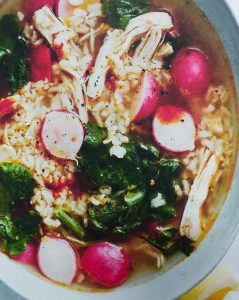 chicken soup with brown rice, radishes, and lots of lemon was a lighter take on chicken soup. If you have cooked chicken on hand, this soup was quick to assemble, and the simmered radishes in it were "a nice twist." Toasted brown rice horchata was a dairy-free version of this cooling Mexican drink; it was "very sweet and very good." Though not essential, it's helpful if you have a nut milk bag for this recipe, an item not widely available. Wild rice with chicken, broccoli, bok choy, and garlic-chile crunch featured brown rice's fancier and more expensive cousin, wild rice. This was a savory one-pot meal loaded with satisfying Asian flavors, but it "needed more rice." Perhaps the author was trying to go easy on our food budgets!
Traditional oats starred in no-bake chocolate-coated oat, date, and cashew bars. These bars were chewy and a bit crumbly, with plenty of nutty and chocolate flavor. And they froze well, always a plus. Rye has recently become a popular partner for chocolate; here it was used in
chicken soup with brown rice, radishes, and lots of lemon was a lighter take on chicken soup. If you have cooked chicken on hand, this soup was quick to assemble, and the simmered radishes in it were "a nice twist." Toasted brown rice horchata was a dairy-free version of this cooling Mexican drink; it was "very sweet and very good." Though not essential, it's helpful if you have a nut milk bag for this recipe, an item not widely available. Wild rice with chicken, broccoli, bok choy, and garlic-chile crunch featured brown rice's fancier and more expensive cousin, wild rice. This was a savory one-pot meal loaded with satisfying Asian flavors, but it "needed more rice." Perhaps the author was trying to go easy on our food budgets!
Traditional oats starred in no-bake chocolate-coated oat, date, and cashew bars. These bars were chewy and a bit crumbly, with plenty of nutty and chocolate flavor. And they froze well, always a plus. Rye has recently become a popular partner for chocolate; here it was used in 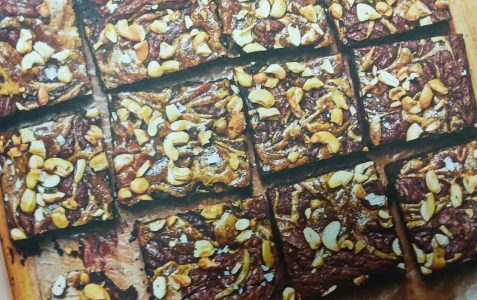 chocolate rye brownies with cashew swirl. These were "super fancy brownies" with a prominent cashew flavor. The rye wasn't evident at all, but no matter-- these were a rich and delicious version of brownies. On a more savory note, rye caraway crackers showcased a classic pairing; "I liked the strong flavors." The dough was somewhat sticky, which made it hard to roll out the crackers thinly, but these were worth trying again.
Most of us have probably only used buckwheat as flour, and our group was no exception. Buckwheat crackers "weren't bad...a bit bland." Much better were buckwheat cream scones your way; these were a huge hit for both people who made them. The scones were rich yet light with a delicate buckwheat flavor, and as the recipe title indicates, you could customize them to your liking. One person added dried cherries and chocolate chips; another embellished with blueberries and a lemon glaze. A keeper! The less common version of buckwheat, groats (or kasha) appeared in buckwheat, lime, and herb salad, larb style. This vegetarian riff on a popular Thai dish didn't make the grade-- the amount of fish sauce was overpowering, and the buckwheat flavor didn't come through. We only tried one recipe with bulgur, but it was a winner: spiced beef and bulgur hand pies. Though it was a bit of work to make the individual turnovers, the filling was "delicious....enhanced by all the spices." if you don't want to deal with the crust, "the filling would be great all by itself!" Sounds like another keeper.
In the back of the book, McFadden includes a chapter he calls "Go-Tos," recipes for various condiments, sauces, and toppings. One person loved the brined and roasted almonds, which had fantastic "really good salty flavor."
chocolate rye brownies with cashew swirl. These were "super fancy brownies" with a prominent cashew flavor. The rye wasn't evident at all, but no matter-- these were a rich and delicious version of brownies. On a more savory note, rye caraway crackers showcased a classic pairing; "I liked the strong flavors." The dough was somewhat sticky, which made it hard to roll out the crackers thinly, but these were worth trying again.
Most of us have probably only used buckwheat as flour, and our group was no exception. Buckwheat crackers "weren't bad...a bit bland." Much better were buckwheat cream scones your way; these were a huge hit for both people who made them. The scones were rich yet light with a delicate buckwheat flavor, and as the recipe title indicates, you could customize them to your liking. One person added dried cherries and chocolate chips; another embellished with blueberries and a lemon glaze. A keeper! The less common version of buckwheat, groats (or kasha) appeared in buckwheat, lime, and herb salad, larb style. This vegetarian riff on a popular Thai dish didn't make the grade-- the amount of fish sauce was overpowering, and the buckwheat flavor didn't come through. We only tried one recipe with bulgur, but it was a winner: spiced beef and bulgur hand pies. Though it was a bit of work to make the individual turnovers, the filling was "delicious....enhanced by all the spices." if you don't want to deal with the crust, "the filling would be great all by itself!" Sounds like another keeper.
In the back of the book, McFadden includes a chapter he calls "Go-Tos," recipes for various condiments, sauces, and toppings. One person loved the brined and roasted almonds, which had fantastic "really good salty flavor." 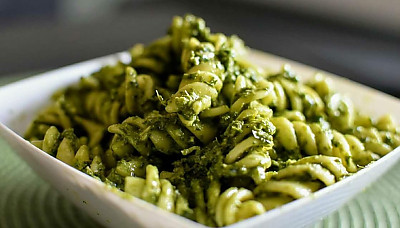 Updated kale sauce for pasta or grains is a newer version of a popular recipe from Six Seasons; this was a beautiful deep green color and was pesto-like with garlic and Parmesan cheese. Unfortunately the garlic flavor became overpowering after the sauce sat in the fridge for a few days, and unless you have a powerful blender, the texture will be somewhat stringy, rather than smooth.
In general, this book seemed rather hit or miss for most of the group. Some couldn't work up any enthusiasm for this book; nothing called to them. For others, as evidenced above, there were at least a few keepers, and several "almosts." Some thought the author was trying too hard to include grains in everything, and some just didn't care for his combinations and/or seasonings. Our overall ambivalence was reflected in our voting: we averaged out to a 2.75 (out of a possible 5). Is that close to a passing grade?
Please join us for our next meeting on Friday, February 24 at 11 AM in the Fireplace Room. We'll be discussing another sophomore effort, Once Upon a Chef Weeknight/Weekend by chef and blogger Jennifer Segal. Copies are available at the main circulation desk or via curbside pickup. See you there!
Updated kale sauce for pasta or grains is a newer version of a popular recipe from Six Seasons; this was a beautiful deep green color and was pesto-like with garlic and Parmesan cheese. Unfortunately the garlic flavor became overpowering after the sauce sat in the fridge for a few days, and unless you have a powerful blender, the texture will be somewhat stringy, rather than smooth.
In general, this book seemed rather hit or miss for most of the group. Some couldn't work up any enthusiasm for this book; nothing called to them. For others, as evidenced above, there were at least a few keepers, and several "almosts." Some thought the author was trying too hard to include grains in everything, and some just didn't care for his combinations and/or seasonings. Our overall ambivalence was reflected in our voting: we averaged out to a 2.75 (out of a possible 5). Is that close to a passing grade?
Please join us for our next meeting on Friday, February 24 at 11 AM in the Fireplace Room. We'll be discussing another sophomore effort, Once Upon a Chef Weeknight/Weekend by chef and blogger Jennifer Segal. Copies are available at the main circulation desk or via curbside pickup. See you there!

